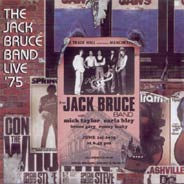The
Jack Bruce Band
Live
'75
(Polydor)
The
recent re-release program which has made the first solo albums by Jack
Bruce available again has made his fans quite happy - while at the same
time making it possible for them to offer tangible evidence to those
who always went "Jack Who?" or wondered what all the fuss
was about. Besides filling a serious documentation gap in the history
of Rock That Counts. It's an undisputed fact that Songs For A Tailor
(his first solo album from 1969) and Harmony Row (from 1971) - with
Out Of The Storm, the follow-up from 1974, being just a tiny bit less
indispensable - are fantastic collections of songs: short in duration
but long in musical inventiveness, where Bruce used his considerable
compositional resources to innovate in the melodic, harmonic and rhythmic
realms thanks to an impressive musical background and to his masterful
technical command of various instruments - the electric bass, obviously
(an instrument that greatly benefited from his contribution), then piano,
organ, harp, cello, vocals. All the re-released CDs benefit from a digital
remastering that's very respectful of the originals and whose sound
is never harsh nor brittle (a rarity these days), with very nice booklets
sporting rare and unreleased pictures and exhaustive and reliable liner
notes.
The
aforementioned studio LPs are the obvious starting point for those unfamiliar
with his work, while Live '75 will be of great interest mainly to those
already in the know. In fact, this double CD - which features a two-hour
long concert recording made at the Manchester Free Trade Hall on 1 June
1975 - is the only official document we have of the Mick Taylor/Carla
Bley quintet: a line-up that at the times seemed destined to scale incredible
highs but which imploded for obscure reasons before actually recording
anything. A few years ago a partial documentation appeared on Live On
The Old Grey Whistle Test ('98), a CD that contained recordings made
for radio; but its mediocre sound, and a repertory that was presented
only in its short tracks, made one wish for more. To tell the truth,
the sound of Live '75 - which was quickly mixed in August 1975 and transferred
to digital last year - is far from perfect, but the quality and variety
of the material make up for it.
The
line-up is well-rehearsed, already quite capable of navigating the perilous
waters of the leader's compositions. Bruce Gary is a solid and versatile
drummer who perfectly reproduces the parts that very different drummers
had played in the studio. Ronnie Leahy is the piano player (acoustic
and electric - Fender) who has to build the foundation for everything
else, a task he fulfills with grace and elegance. Mick Taylor - fresh
off the Rolling Stones - is the "rock guitarist" who's perfect
for stompers like Keep It Down or for blues moments such as the section
in Post War where Bruce had originally played the harmonica - here Taylor
wisely uses the bottleneck - while during some of the more harmonically
"open" moments such as the Smiles And Grins coda, to which
Carla Bley's Mellotron gives a very "Crimson" air, he seems
a bit uncomfortable. Carla Bley plays mostly the Hammond organ, from
which she extracts her usual original signature timbre, and the Mellotron;
always tasteful, always appropriate are the parts that essentially reproduce
what Bruce himself had played in the studio, but nice original touches
abound - see the "cosmic" Mellotron here and there, or her
Hammond on Tickets To Waterfalls, which (starting from about 10') sounds
quite like an anticipation of her Dinner Music LP.
Sure,
with hindsight it's quite easy to foresee what did not, in fact, work.
But the occasional tentativeness of some of these performances brings
us back to those long-gone days when the bandstand was the place where
a musical synthesis - and the musicians' mutual satisfaction - had to
be attained at levels that went way beyond the lowest common denominator
(however nowadays disguised).
Beppe
Colli
©
Beppe Colli 2003
CloudsandClocks.net
| June 10, 2003











